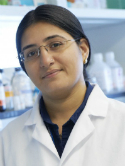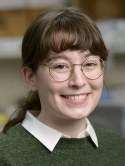Measuring nonhomologous end-joining, homologous recombination and alternative end-joining simultaneously at an endogenous locus in any transfectable human cell Journal Article
| Authors: | Hussain, S. S.; Majumdar, R.; Moore, G. M.; Narang, H.; Buechelmaier, E. S.; Bazil, M. J.; Ravindran, P. T.; Leeman, J. E.; Li, Y.; Jalan, M.; Anderson, K. S.; Farina, A.; Soni, R.; Mohibullah, N.; Hamzic, E.; Rong-Mullins, X.; Sifuentes, C.; Damerla, R. R.; Viale, A.; Powell, S. N.; Higginson, D. S. |
| Article Title: | Measuring nonhomologous end-joining, homologous recombination and alternative end-joining simultaneously at an endogenous locus in any transfectable human cell |
| Abstract: | Double strand break (DSB) repair primarily occurs through 3 pathways: non-homologous end-joining (NHEJ), alternative end-joining (Alt-EJ), and homologous recombination (HR). Typical methods to measure pathway usage include integrated cassette reporter assays or visualization of DNA damage induced nuclear foci. It is now well understood that repair of Cas9-induced breaks also involves NHEJ, Alt-EJ, and HR pathways, providing a new format to measure pathway usage. Here, we have developed a simple Cas9-based system with validated repair outcomes that accurately represent each pathway and then converted it to a droplet digital PCR (ddPCR) readout, thus obviating the need for Next Generation Sequencing and bioinformatic analysis with the goal to make Cas9-based system accessible to more laboratories. The assay system has reproduced several important insights. First, absence of the key Alt-EJ factor Pol theta only abrogates similar to 50% of total Alt-EJ. Second, single-strand templated repair (SSTR) requires BRCA1 and MRE11 activity, but not BRCA2, establishing that SSTR commonly used in genome editing is not conventional HR. Third, BRCA1 promotes Alt-EJ usage at two-ended DSBs in contrast to BRCA2. This assay can be used in any system, which permits Cas9 delivery and, importantly, allows rapid genotype-to-phenotype correlation in isogenic cell line pairs. |
| Keywords: | tumors; resection; brca1; damage; dna-repair; double-strand-break; ctip; 53bp1; mutational signatures |
| Journal Title: | Nucleic Acids Research |
| Volume: | 49 |
| Issue: | 13 |
| ISSN: | 0305-1048 |
| Publisher: | Oxford University Press |
| Date Published: | 2021-07-21 |
| Start Page: | e74 |
| Language: | English |
| ACCESSION: | WOS:000685211300002 |
| DOI: | 10.1093/nar/gkab262 |
| PROVIDER: | wos |
| PMCID: | PMC8287935 |
| PUBMED: | 33877327 |
| Notes: | Article -- Source: Wos |
Altmetric
Citation Impact
BMJ Impact Analytics
MSK Authors
Related MSK Work

















